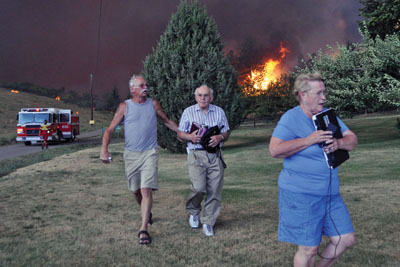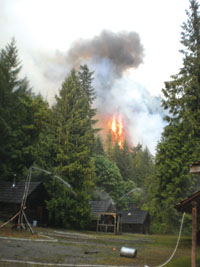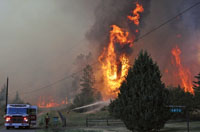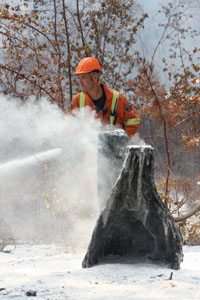
Features
Hot topics
Incident reports
Anatomy of a wildfire
The peak of the 2009 wildfire season hit the Central Okanagan Valley in mid July, about a month earlier than usual. Three major interface fires made up what the British Columbia Forest Service termed the West Kelowna Complex, which ran for almost 45 days.
November 16, 2009
By Lou Wilde
The peak of the 2009 wildfire season hit the Central Okanagan Valley in mid July, about a month earlier than usual. Three major interface fires made up what the British Columbia Forest Service termed the West Kelowna Complex, which ran for almost 45 days. Besides the protection branch of the B.C. Forest Service, the incident was commanded by forestry officials from Ontario, California and Australia by the time it was deemed under control and contained.
I met with Fire Chief Wayne Schnitzler of the West Kelowna Fire Rescue to recount the first operational period (12 hours) of the Glenrosa fire, the Rose Valley fire and the Terrace Mountain fire. What follows is a snapshot of our operations, some of the successes and lessons learned.
 |
| Kelowna residents Rev. Les and Shirley Hamm were canning fruit when the fires began. They fled their home with whatever they could carry after watching the blaze take a nearby home. Photo by John MacDonald, Kelowna.com |
The Glenrosa fire was reported on July 18 at 14:40 hours and began on the fringe of the Glenrosa subdivision in the south end of West Kelowna, which is home to about 6,000 residents. The neighbourhood is made up of small acreages, which were in the immediate area of the fire, and urban-type homes on smaller lots half a kilometre to the north. Due to the Okanagan’s extremely dry climate (and minimal rainfall this summer), wildfires accelerate quickly and have to be acted on immediately using all necessary resources. The temperature that day was 37 C with wind gusting to 70 kilometres an hour; the humidity was at just 13 per cent. As time is paramount, we’ve learned that there is only a small window of opportunity during which we can make an impact on a wildfire when it is first reported. In the Central Okanagan, fire departments usually act on fires outside their regular response areas rather than waiting for the fires to enter their jurisdictions; there is no time to waste when calling for resources, whether it’s mutual aid or the BC Forest Service. Our fire departments have a great working relationship with the protection branch of the BC Forest Service. We often cross jurisdictional lines to help each other with response and resources.
As Chief Schnitzler arrived on scene, one of his first acts was to request the opening of the Central Okanagan Regional District Emergency Operations Centre as it was obvious that many people were going to be affected by this fire. The EOC was opened to a level 2, which includes the basic support of an operations section chief, liaison officer, police, fire, ambulance, emergency health services, planning-section chief, public information officer and a director (CAO) representing the municipality. Schnitzler had established incident command at the intersection of Apollo Street and Brown Road, from where officials could watch the rank 4 or 5 fire, which by that point was within metres of the south flank of the Glenrosa subdivision and just a kilometre from Gorman Bros. Lumber Ltd. The RCMP members on duty that day were performing a tactical evacuation and traffic control. A call had already been put out for assistance from the BC Forest Service protection branch based out of Vernon and Penticton, which was responding with five helicopters, two unit crews (20 members), an initial attack crew of between three and five, two water tenders, two bulldozers, a tanker group (one bird dog plane and two to three air tankers) as well as a type 1 incident commander from the Vernon base. Through the EOC, Schnitzler also requested mutual aid from the other local fire departments and, within the first half hour, three engines, four bush trucks and three tenders were on their way from Lake Country, Ellison, Joe Riche, Kelowna and Peachland under the Central Okanagan Regional District mutual-aid agreement.
Assistant Chief Darren Lee from West Kelowna Fire Rescue was made the Upper Glenrosa division supervisor and a general page was put out for the 22 career and 60 paid on-call staff. As the incident developed, three divisions were established to maintain a working span of control: the Gorman division, led by Capt. Mike McGuire; the north division, led by Assistant Chief Darren Lee (both of WKFR); and the south division, led by Platoon Capt. Shawn O’Reilly (Kelowna Fire Department).
 |
|
| Sprinklers wet down farm buildings during the B.C. blazes in August. Photo courtesy Quintech Fire |
“As the incident commander you need a good visual vantage point on an incident of this size in order to develop your strategy,” Chief Schnitzler recalls. “It’s difficult for the division supervisor to have perspective of what is happening around him when he’s in the middle of things. They sometimes have a difficult time deciding their next move because of their limited view of the situation.”
From a tactical perspective, fire crews needed to stay mobile. Firefighters couldn’t afford to lay huge amounts of supply line and stretch multiple 2.5-inch handlines to protect individual homes. They had to triage homes and properties on the run, suppressing multiple spot fires caused by the flying brands and the 70 kilometre per hour wind that were igniting ground fires 500 metres ahead of the rank 4 fire. As the chief put it, “the worst mistake that a task force leader or company officer can make is committing to a pinpoint. The officer must maintain a wide field of view evaluating the ever-changing dynamics around him. Dynamics of an interface fire of this magnitude change in such rapid succession that it’s often difficult to prioritize efforts.”
From an incident command perspective, managing an interface fire the size of the Glenrosa blaze can be like directing several commercial fires at once. “You rely on your experience from past fires and your decision-making abilities” says Chief Schnitzler. “It’s one thing to delegate the protection of neighborhoods to a division supervisor but it’s another to make decisions on all the other stuff.”
Consider the many decisions: How many more apparatus are needed? How many tenders, engines, bush trucks? Did we get a request in for forestry assistance (air support) since it’s within our jurisdiction? How many more firefighters? Where can we set up staging for apparatus that is close but not too close? Who can I get right now for a staging manager? What streets need to be evacuated now? We need to set up a unified command with a number of agencies (WKFR, RCMP, BC Forest Service, and ambulance) somewhere other than the hood of my truck. What have we got for a hydrant system in the involved area? Did my only other assistant chief go out of town on his holidays? How long until he can get back? And what about fuel for apparatus, food, drinking water, back-up power for the water system in case the power goes out or power lines are destroyed by fire?
Within two hours a formal unified command had been established two kilometres north of the fire at Emmanuel Assembly Church, which offered tables and chairs, whiteboards, landlines, washrooms and a great vantage point of the ensuing fire. Representatives from WKFR, RCMP, ambulance and BC Forestry were now at the command post. It was imperative that public information come from the unified command post via the EOC and the message represented all agencies involved. Staging was set up at Station 31 in downtown West Kelowna so that there was control of who was going into action.
“We were able to get staging set up pretty quick so dispatch could direct resources there instead of trying to relay which street they were to respond to,” Schnitzler adds. At this point the interface fire was almost 70 hectares; there were about 30 pieces of apparatus, more than 150 people on the ground and eight aircraft working this fire.
 |
|
| West Kelowna’s Engine 31 protects a residence as a tree “candles” in the yard. Photo by Kelowna.com |
“It almost becomes like a hazmat call where you need to rush to the scene and then slow right down,” says Schnitzler. “You need to assess the situation, evacuate public and determine where to allocate your limited resources, assign people to tasks, and put them to work then begin to evaluate progress and plan for what’s next.”
Within the same period of time, the EOC had been staffed to level 3 with about 60 people from a number of agencies. The public information officer put out press releases informing residents of the fire and detailing which streets were being evacuated as fast as the command post was calling them in. The EOC liaison officer was in contact with the Provincial Emergency Program headquarters in Victoria getting the official evacuation declarations completed. The emergency social services members were on their way to a local high school to register evacuees. BC Hydro was asked to assess and address the power outage. The fire was spreading west (out of town) and was a threat to the main transmission line supplying the entire community as well as the town of Peachland, five kilometres to the south. Things were changing quickly; there were more people to put on evacuation alert and more to order out. More resources were needed. Every new evacuation required the mapping staff in the planning section of the EOC to draft another map that would identify for the media the new status of evacuations. The Interior Health Authority needed to be called in because senior care facilities could be affected and hotels needed to be called (in the middle of July) to house evacuated residents. At about 18:00 hours (almost four hours into the fire) the command post had to move again because the church lost power and command called for the evacuation of the area around the church. Shannon Lake Elementary school was five kilometres away and had power. Thankfully, there was a school district representative in the EOC who had the authority and contacts to open two schools during summer holidays at a moment’s notice.
It was decided that our first operational period for this event would go 12 hours with shift change (EOC and site) at 02:00 on Sunday, July 19.
Tactically, out in the field, firefighters made an amazing stand at Gorman’s lumber mill. Some raw logs and lumber products were lost but the facility and more than 400 jobs were saved. The bad news was that the fire spread east and had jumped the four lanes of Highway 97, the only highway connecting all the Okanagan Valley communities, and was headed downhill with a 60-kilometre-an-hour wind pushing it toward Power’s Creek Canyon. The command post called for the evacuation of the easterly exposed Gellatly neighbourhood and eight square blocks of downtown West Kelowna (commercial and residential). By 18:00 hours the fire had spread to 250 hectares and another 3,000 people had been evacuated.
“Firefighters had to triage properties quickly,” Chief Schnitzler recalls. “Was the home defendable? Were the property owners practising Fire Smart recommendations with green space around their home, non-combustible building products and removing ladder fuels? What kind of escape route did firefighters have from the property if things turn bad?”
After the fire crossed Highway 97 it headed toward Okanagan Lake and the only sewage treatment plant for West Kelowna and Peachland. Again, task forces were directed to make a stand similar to that at the lumber mill. Losing the sewage plant for two communities could mean weeks of repair and could put both communities on evacuation order. How many porta-johns would we need for 35,000 people?
At the command post the BC Forest Service was working on plans for the next operational period with more than 150 forestry firefighters. The firefighters would need a place to camp so the Westbank First Nation rep in the EOC was asked for permission to set up a forestry camp in a baseball stadium on First Nation land. This camp became home to more than 350 forestry firefighters and operated until late August.
If things weren’t surreal enough, at 21:30 hours, a 911 call reported another wildland fire on the west shore of the Rose Valley reservoir in West Kelowna, 8.5 kilometres from the Glenrosa fire. Resources had to be pulled from Glenrosa to deal with this fire. Fortunately, the BC Forest Service got a chopper on site quickly to assess and act on the fire from the air as the fire burned away from nearby homes. The terrain was too difficult to put firefighters on site so a few were left to watch for spot fires near homes. The Rose Valley fire grew to 150 hectares before being contained and forced the evacuation of about 8,000 people. In all, 17,000 residents of West Kelowna were ordered out of their homes on July 18, many for an entire week before unified command allowed them to return. Work to contain the 400-hectare Glenrosa fire and the 150-hectare Rose Valley fire took almost two weeks before it was termed “out”.
With the two active wildland fires in West Kelowna and a 500-hectare fire burning some 30 kilometres to the northwest, the BC Forest Service designated the area as the West Kelowna Complex, meaning all three fires would be operated under the same unified command team in order to share resources and intelligence. By July 20, the Terrace Mountain fire was 1,300 hectares and by July 21 it was 1,800 hectares.
On July 22, while fire crews were in mop up in West Kelowna, the Central Okanagan’s rural fire department co-ordinator, Rod Miller, and I drove to the bedroom community of North West Side, home to about 2,500 residents, to meet with Fire Chief Wayne Carson. The Terrace Mountain Fire was now 2,700 hectares and fewer than 10 kilometres from Carson’s jurisdiction. From past experience in the Okanagan, we know that wildfire can make a four- or five-kilometre run in a day, so we were triaging and planning for the B.C. fire commissioner’s representative John Kenyon, who filled the role of structural branch director under the unified command. Kenyon had responded two days earlier with three of the province’s sprinkler protection units, complete with crews. Each of the sprinkler units could offer protection to about 20 homes deemed “defendable”. Plans were drafted to identify the few water sources (hydrants), identify safe zones so that fire crews could “retreat and return”, identify geographical divisions, identify key members for placement in an organizational chart, identify look-out points, print maps and make plans for back-up power for pump stations and so on. With plans drafted, all we needed was a fire. Because North West Side is remote and difficult to access, we ended up staging resources in the area ahead of the expected fire.
 |
|
| The West Kelowna Complex, with its three fires, was a success in most accounts. All three fires appeared to have been caused by humans. Photo by Chris Stanford, Kelowna.com |
The narrow, winding 25-kilometre drive to North West Side was the only way in, so we planned to evacuate the public north to the City of Vernon so that emergency vehicles could respond from the south. The two-bay fire hall in Wilson’s Landing, led by Fire Chief Derek Fletcher, is about 10 kilometres from North West Side so it was used as our staging area on Aug. 1, when the threat of fire became imminent. Twelve more units were brought in to supplement the two local fire departments with a staff of about 70 members. For seven days (14 operational periods), assistant chiefs Darren Lee and Kerry Klonteig from West Kelowna Fire Rescue and I shared the role of North West Side branch director. We established three division supervisors with task forces to perform “Fire Smarting” on the local properties while the BC Forest Service, with about 400 members, 15 helicopters and more than 90 pieces of heavy equipment, cut fire guards and performed back burns in an effort to save this small community on the shores of Lake Okanagan. Each operational period would begin with a briefing for structural crews at the staging area with the most current intelligence gathered at the previous night’s planning meeting held by the unified command. From this, duties and priorities would be delegated to division supervisors for the day. The forest service’s efforts on the community’s outskirts were successful and, on Aug. 7, the last of the mutual-aid companies was demobilized without seeing action.
The West Kelowna Complex, with its three fires, was a success in most accounts. All three fires appear to have been caused by humans but were still under investigation at press time. Three homes were lost, along with some vehicles and outbuildings, but there were no deaths or serious injuries. As Chief Schnitzler put it, “Over the years we (the regional municipalities and fire service) have put together an EOC with great people with experience. Our fire departments have developed a great working relationship through our mutual-aid agreement, the Regional Emergency Program and Regional Rescue Program. We’ve known and used ICS for years but we’re implementing it better now primarily through the experience we’ve gathered from interface incidents like the West Kelowna Complex”.
| FireSmart recommendations
The B.C. edition of the FireSmart manual can be found online at www.pep.bc.ca/hazard_preparedness/FireSmart-BC4.pdf It includes the following recommendations:
|
Print this page